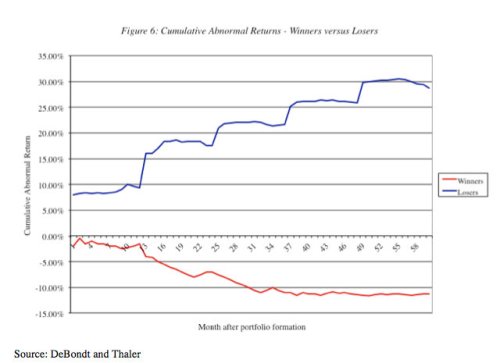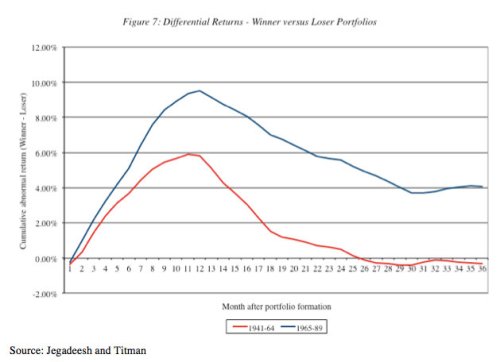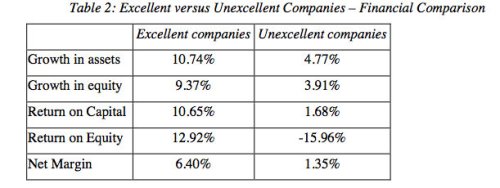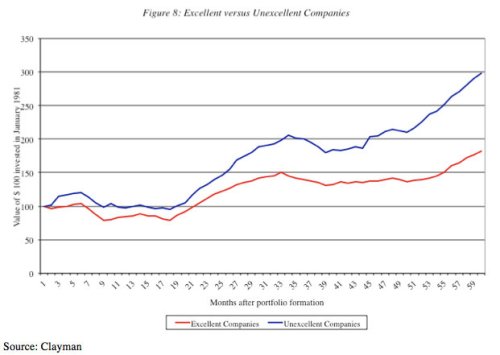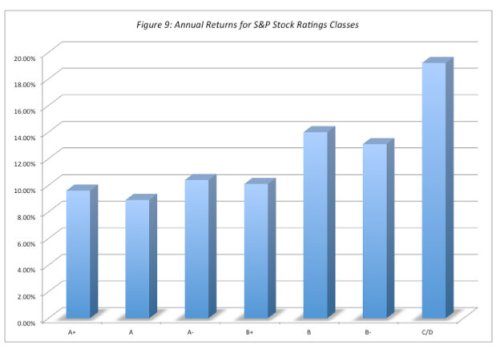Since Joel Greenblatt’s introduction of the Magic Formula in the 2006 book “The Little Book That Beats The Market,” researchers have conducted a number of studies on the strategy and found it to be a market beater, both domestically and abroad.
Greenblatt claims returns in the order of 30.8 percent per year against a market average of 12.3 percent, and S&P500 return of 12.4 percent per year:

In Does Joel Greenblatt’s Magic Formula Investing Have Any Alpha? Meena Krishnamsetty finds that the Magic Formula generates annual alpha 4.5 percent:
It doesn’t beat the index funds by 18% per year and generate Warren Buffett like returns, but the excess return is still more than 5% per year. This is better than Eugene Fama’s DFA Small Cap Value Fund. It is also better than Lakonishok’s LSV Value Equity Fund.
Wes Gray’s Empirical Finance Blog struggles to repeat the study:
[We] can’t replicate the results under a variety of methods.
We’ve hacked and slashed the data, dealt with survivor bias, point-in-time bias, erroneous data, and all the other standard techniques used in academic empirical asset pricing analysis–still no dice.
In the preliminary results presented below, we analyze a stock universe consisting of large-caps (defined as being larger than 80 percentile on the NYSE in a given year). We test a portfolio that is annually rebalanced on June 30th, equal-weight invested across 30 stocks on July 1st, and held until June 30th of the following year.

Wes finds “serious outperformance” but “nowhere near the 31% CAGR outlined in the book.
Wes thinks that the outperformance of the Magic Formula is due to small cap stocks, which he tests in a second post “Magic Formula and Small Caps–The Missing Link?”
Here are Wes’s results:

[While] the MF returns are definitely higher when you allow for smaller stocks, the results still do not earn anywhere near 31% CAGR.
Some closer observations of our results versus the results from the book:
For major “up” years, it seems that our backtest of the magic formula are very similar (especially from a statistical standpoint where the portfolios only have 30 names): 1991, 1995, 1997, 1999, 2001, and 2003.
…
The BIG difference is during down years: 1990, 1994, 2000, and 2002. For some reason, our backtest shows results which are roughly in line with the R2K (Russell 2000), but the MF results from the book present compelling upside returns during market downturns–so somehow the book results have negative beta during market blowouts? Weird to say the least…
James Montier, in a 2006 paper, “The Little Note That Beats the Markets” says that it works globally:
The results of our backtest suggest that Greenblatt’s strategy isn’t unique to the US. We tested the Little Book strategy on US, European, UK and Japanese markets between 1993 and 2005. The results are impressive. The Little Book strategy beat the market (an equally weighted stock index) by 3.6%, 8.8%, 7.3% and 10.8% in the various regions respectively. And in all cases with lower volatility than the market! The outperformance was even better against the cap weighted indices.
So the Magic Formula generates alpha, and beats the market globally, but not by as much as Greenblatt found originally, and much of the outperformance may be due to small cap stocks.
The Magic Formula and EBIT/TEV
Last week I took a look at the Loughran Wellman and Gray Vogel papers that found the enterprise multiple, EBITDA/enterprise value, to be the best performing price ratio. A footnote in the Gray and Vogel paper says that they conducted the same research substituting EBIT for EBITDA and found “nearly identical results,” which is perhaps a little surprising but not inconceivable because they are so similar.
EBIT/TEV is one of two components in the Magic Formula (the other being ROC). I have long believed that the quality metric (ROC) adds little to the performance of the value metric (EBIT/EV), and that much of the success of the Magic Formula is due to its use of the enterprise multiple. James Montier seems to agree. In 2006, Montier backtested the strategy and its components in the US, Europe ex UK, UK and Japan:
The universe utilised was a combination of the FTSE and MSCI indices. This gave us the largest sample of data. We analysed the data from 1993 until the end of 2005. All returns and prices were measured in dollars. Utilities and Financials were both excluded from the test, for reasons that will become obvious very shortly. We only rebalance yearly.
Here are the results of Montier’s backtest of the Magic Formula:
And here’re the results for EBIT/TEV over the same period:
Huh? EBIT/TEV alone outperforms the Magic Formula everywhere but Japan?
Montier says that return on capital seems to bring little to the party in the UK and the USA:
In all the regions except Japan, the returns are higher from simply using a pure [EBIT/TEV] filter than they are from using the Little Book strategy. In the US and the UK, the gains from a pure [EBIT/TEV] strategy are very sizeable. In Europe, a pure [EBIT/TEV] strategy doesn’t alter the results from the Little Book strategy very much, but it is more volatile than the Little Book strategy. In Japan, the returns are lower than the Little Book strategy, but so is the relative volatility.
Montier suggests that one reason for favoring the Magic Formula over “pure” EBIT/TEV is career defence. The backtest covers an unusual period in the markets when expensive stocks outperformed for an extended period of time.
The charts below suggest a reason why one might want to have some form of quality input into the basic value screen. The first chart shows the top and bottom ranked deciles by EBIT/EV for the US (although other countries tell a similar story). It clearly shows the impact of the bubble. For a number of years, during the bubble, stocks that were simply cheap were shunned as we all know.
However, the chart below shows the top and bottom deciles using the combined Little Book strategy again for the US. The bubble is again visible, but the ROC component of the screen prevented the massive underperformance that was seen with the pure value strategy. Of course, the resulting returns are lower, but a fund manager following this strategy is unlikely to have lost his job.
In the second chart, note that it took eight years for the value decile to catch up to the glamour decile. They were tough times for value investors.
Conclusion
The Magic Formula beats the market, and generates real alpha. It might not beat the market by as much as Greenblatt found originally, and much of the outperformance is due to small cap stocks, but it’s a useful strategy. Better performance may be found in the use of pure EBIT/EV, but investors employing such a strategy could have very long periods of lean years.
Buy my book The Acquirer’s Multiple: How the Billionaire Contrarians of Deep Value Beat the Market from on Kindle, paperback, and Audible.
Here’s your book for the fall if you’re on global Wall Street. Tobias Carlisle has hit a home run deep over left field. It’s an incredibly smart, dense, 213 pages on how to not lose money in the market. It’s your Autumn smart read. –Tom Keene, Bloomberg’s Editor-At-Large, Bloomberg Surveillance, September 9, 2014.
Click here if you’d like to read more on The Acquirer’s Multiple, or connect with me on Twitter, LinkedIn or Facebook. Check out the best deep value stocks in the largest 1000 names for free on the deep value stock screener at The Acquirer’s Multiple®.










